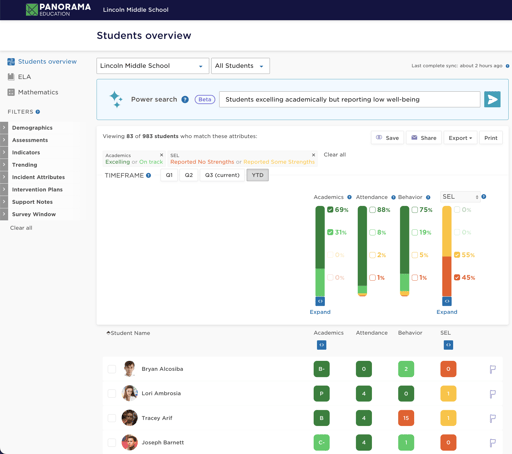Artificial Intelligence (AI) is playing an increasingly important role in the world of K-12 education. From creating personalized learning experiences to generating unique insights about teaching dynamics, it is clear that AI-powered learning tools can help enable new forms of interaction between educators and students.
Yet, guidance for state and district leaders has been few and far between. While analysis from the Center on Reinventing Public Education at Arizona State University revealed that school and district administrators “would like more state guidance on using generative AI ethically and responsibly,” at least 27 states—including Arizona, California, Colorado, Connecticut, Delaware, Hawaii, Indiana, Kentucky, Louisiana, New Jersey, North Carolina, North Dakota, Minnesota, Mississippi, Missouri, Michigan, Montana, Ohio, Oklahoma, Oregon, South Carolina, Utah, Virginia, Washington, West Virginia, Wisconsin, and Wyoming alongside Puerto Rico—have published formal guidance to school districts regarding the use of AI in schools.
Ahead of more in-depth guidance that is expected to be developed in 2024, the U.S. Department of Education’s Office of Educational Technology released its first AI-related resource this past spring. The policy report, titled: “Artificial Intelligence and the Future of Teaching and Learning,” emphasizes the potential of AI to enhance teaching and learning while also highlighting the need for careful consideration of the practical, safety, and bias-related implications.
This article unpacks the Department of Education’s report and provides district leaders with practical recommendations to effectively implement the report’s key insights in their school communities.
Download Panorama's AI Toolkit
What Is AI and How Can It Be Used In Schools?
AI refers to the simulation of human intelligence processes by machines. The report begins with a preliminary definition of AI (“automation based on associations”) and elaborates to share three additional perspectives for educators to consider. These perspectives are not just theoretical; they represent different ways that AI can be utilized in K-12 education, each with its own set of applications and implications.
AI as Human-Like Reasoning
The first definition of Artificial Intelligence views AI as a tool that emulates human cognitive processes. Computer systems can be trained to perform tasks that normally require human intelligence, such as speech recognition, decision-making, natural language processing, and visual perception. The aim here is to use AI to replicate and extend the natural abilities of humans in processing and analyzing information.
However, the authors of the report caution that while the idea of “human-like” can be helpful in defining AI, it is important to acknowledge that AI processes information differently from how humans process information.
AI as a Goal-Pursuing Algorithm
Under this view, AI is seen as a system designed to identify patterns and make decisions to achieve specific goals. Emerging AI tools and large language models (LLMs) are built to identify patterns and select actions to achieve a specified goal.
This is particularly relevant in educational settings. The ability of AI to recognize trends, automate recommendations, and adapt teaching materials to individual student needs has big implications with regards to personalized learning systems. Many computer-aided instruction services already use AI to give students feedback, nudge them with hints and suggestions to improve their writing skills, and alter the scope-and-sequence to meet their needs.
AI as Intelligence Augmentation
The third definition centers human intelligence and decision-making while acknowledging that assistive tools can support human reasoning. Here, AI is not replacing the teacher but is being used to augment their capabilities.
Tools like Khan Academy’s AI-powered guide, Khanmigo, exemplify this approach by generating lesson plans and providing insightful student feedback, thus freeing up educators’ time for more personalized student interactions. Panorama Education's new AI-powered student support tools adopt a similar approach to facilitate more effective and efficient decision-making when it comes to identifying trends in data and pinpointing student challenges..png?width=678&height=453&name=unnamed%20(10).png)
Panorama Insights (demo data displayed)
By understanding these three perspectives, educators and administrators can better appreciate the diverse applications of AI in education. Each view offers a different approach to leveraging technology to enhance teaching and learning—reflecting the varied needs and goals within educational environments.
Key Takeaways from the Report
The 71-page report emphasizes the imperative for district and school leaders to transparently disseminate knowledge about AI, involve educators and communities in decision-making processes, and utilize stakeholder feedback to shape and continuously refine AI-related policies and practices in education.
This quote from the report underscores a critical discussion in the application of AI in educational settings:
|
|
While AI is adept at automating and optimizing processes to achieve predetermined goals, it lacks the human insight necessary to set these objectives. The goals of education – fostering critical thinking, creativity, and growth – are deeply rooted in human expertise and an understanding of individual needs. These are areas where AI cannot independently operate.
The report also details AI's potential in transforming:
- Real-time feedback loops
- Educator support
- Individualized student support
- Personalized and adaptive student learning
- Teacher-student interactions
- Learner variability
Finally, the authors outline many of the risks of AI (such as algorithmic bias) and stresses the need for trust, safety, and safeguards to protect both educators and students. The report repeatedly underscores the need for a human-centric approach to AI integration in schools that uses AI as a complementary tool to support, not replace, the expertise and judgment of educators. This balance ensures that technology serves as the pedagogical vision and meets the unique needs of each student, rather than dictating the strategy itself.
What Does the U.S. Department of Education Recommend?
In “Artificial Intelligence and the Future of Teaching and Learning,” the U.S. Department of Education calls on education leaders to follow a set of seven recommendations that can help drive conversations about AI (and AI implementation) forward in their respective school communities.
|
|
1. “Emphasize Humans-in-the-Loop”
This recommendation describes how involving teachers and other staff in AI applications is crucial to maintain human insight and control in education. It underscores the importance of human judgment in interpreting AI-generated data and making decisions, ensuring that AI serves as a tool to augment, not replace, the human element in teaching and learning.
2. “Align AI Models to a Shared Vision for Education”
This guideline focuses on aligning generative AI tools and systems with the overarching educational vision and values of a school district, ensuring they contribute effectively to teaching and learning. It suggests that AI should be a reflection of the community's educational values and should be used to enhance the overall teaching and learning experience, rather than dictate it.
3. “Design AI Using Modern Learning Principles”
Incorporating modern learning theories and practices into the development of AI systems is crucial. This approach calls the design of AI systems rooted in modern educational theories and practices, emphasizing the role of educational expertise and fairness. The focus here is on creating AI that is equitable and supportive of a wide range of learning styles and needs.
4. “Prioritize Strengthening Trust”
The report emphasizes the importance of building trust in AI technologies among educators and decision-makers through transparency, reliability, and community engagement. It calls for transparent, reliable AI solutions and active engagement with the educational community to foster a shared understanding and acceptance of AI technologies.
5. “Inform and Involve Educators”
The authors repeatedly stress the need for educators to be well-informed and actively involved in the application of AI, with a focus on understandable and controllable systems. It highlights the importance of AI systems being understandable and manageable by educators, enabling them to use these tools effectively and confidently.
6. “Focus R&D on Addressing Context and Enhancing Trust and Safety”
There is a clear emphasis on the importance of research in adapting AI to diverse educational settings and enhancing trust and safety in AI applications for education.
7. “Develop Education-Specific Guidelines and Guardrails”
This recommendation calls for the development of specific guidelines and safety measures for AI in education, addressing its unique challenges and opportunities. It addresses the need for specific rules and measures to manage the unique challenges and opportunities presented by AI, ensuring its safe and effective use in educational settings.
Integrating Artificial Intelligence Within Your District
District leaders are well-positioned to navigate the plethora of opportunities presented by artificial intelligence in their school communities. Successfully implementing the Department of Education’s recommendations will require administrators to strike a harmonious balance between adopting these new technologies while preserving the human essence at the heart of education.

Educators can quickly identify trends with Panorama's new AI-powered tools
Championing a Human-Centric Approach to AI Adoption
Firstly, education leaders must champion the concept of human-centric AI adoption. Artificial intelligence and machine learning will never replace teachers, but we can leverage this new technology to enrich the educational experience while retaining the human touch that is so fundamental to effective pedagogy and learning.
“Emphasizing humans in the loop” means selecting AI tools that enhance – rather than replace – the collaborative efforts of teachers. By promoting technology that supports team-based problem-solving approaches, educators can better coordinate to address individual student needs, share insights, and develop more cohesive intervention strategies. For example, new AI-powered student support tools in Panorama can help Student Support Teams analyze, describe, and act upon student data in even more powerful ways.
Building a Foundation of Trust and Transparency
Transparency and trust are two other cornerstones of successfully integrating AI in educational settings. District leaders can play an important role in selecting AI tools that are not only effective but also user-friendly and easily comprehensible for all stakeholders, including educators, families, and caregivers.
Two-way communication is key to fostering trust and innovation within the school community – explaining how AI is being employed, outlining its potential benefits, and acknowledging its limits. Maintaining an open dialogue will not only increase transparency but also encourage innovation and collaboration within the school community.
Prioritizing Safety and Data Privacy in AI Integration
Safety – particularly regarding student data privacy – is non-negotiable. Leaders must ensure that AI tools adhere to the highest standards of data protection and privacy. This commitment to safety involves several steps: training staff (and students) on best practices in data privacy, actively involving stakeholders in discussions about data usage and security, and conducting thorough evaluations of AI vendors to ensure they comply with stringent data protection standards and guard against unauthorized access.
By prioritizing these measures, leaders can help ensure that AI applications are not only innovative and effective but also ethical and secure, maintaining the trust of the school community and protecting the interests of all students.
While there are undoubtedly many challenges and uncertainties surrounding Artificial Intelligence in K-12 education, this period also represents a unique opportunity to significantly shape the future of education. As we continue to navigate this new and evolving chapter, integrating AI into our classrooms in thoughtful, ethical, and human-centric ways can help us ensure that technology acts as a tool for empowerment and inclusion—fostering a future where education is more adaptable, personalized, and accessible to all students.
Download Resources to Support AI Implementation in Your District







-2.png?width=1280&height=853&name=Untitled%20design%20(5)-2.png)